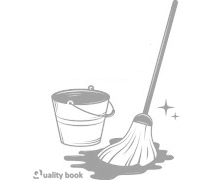Housekeeping refers to the management of duties and tasks involved in household assignments, such as cleaning, cooking, home maintenance, shopping, laundry, and bill paying.
A housekeeper is a person employed to manage a household and domestic staff.
The general care, cleanliness, order, and maintenance of a business or property. Good housekeeping is an important consideration in fire hazard and other forms of insurance, as well as certification by fire, health, and industrial safety agencies.

- A neat and clean workplace leads to higher productivity.
- A neat and clean workplace produces fewer defects.
- Clean and tidy reduces costs by reducing workspace.
- List.
- A clean and tidy workspace helps meet delivery deadlines better.
- A clean and tidy workplace boosts morale employees.
- A neat and clean workplace is a much safer place to work.
What is Good Housekeeping?
The general care, cleanliness, order, and maintenance of a business or property. Good housekeeping is an important consideration in fire hazard and other forms of insurance, as well as certification by fire, health, and industrial safety agencies.
Avoid Housekeeping Problems, Such as:
- The factory becomes increasingly crowded and work becomes difficult.
- Require additional lockers, shelves, and cabinets for storage.
- Unwanted material, thus increasing the space.
- Time is wasted searching for tools and parts.
- Excess inventory results in higher costs for the product.
- Excess stock on hand hides other types of problems in production.
- Unnecessary items and equipment make it difficult to make process improvements.
- Possibility of “mix-up” during processing.
Systematic Arrangement – To make, reorder, or write down a rational, orderly, and orderly arrangement of all the things we use.
Why is it important?
Turn workplaces into clean, bright places where everyone will enjoy working.
Keep everything in top condition so that when someone needs to use something, it’s ready to use.
- Cleaning is also moved from a quarterly or yearly end.
- Do 5 or 10 minutes of activity every day.
- Cleansing should be done like a daily ablution bath
Standardize your work.
Standardization is the result that exists when the first three pillars – sort, set-in-order, and shine – are properly maintained.
- If we don’t standardize, this place gets bogged down very quickly.
- In this step, we learn about keeping everything clean by creating standards.
To maintain means to make a habit of maintaining properly the right procedure.
Self-discipline
Here are some of the things that mostly happen in a company when the commitment to 5S is not sustains.
- The accumulation of essential items does not begin as soon as the sorting is complete.
- No matter how well the set-in order is plan and implement well, tools and jigs do not return to their designate places after use.
- No matter how dirty the equipment gets, little or nothing is complete to clean it.
- Items are left in walkways, tripping over and injuring people.
- Dirty machines tend to break down and produce defective goods.
Housekeeping is not just about cleanliness. The main purpose of housekeeping is to ensure cleanliness, hygiene, privacy, comfort, and health for a safe environment. Productive housekeeping can help eliminate workplace hazards.
This includes keeping your work areas neat and orderly, cleaning hallways properly, making floors non-slip and travelling. We must pay attention to all the big and small important details regarding the entire layout, maintenance and storage facilities of the workplace or home. Always practice good housekeeping!